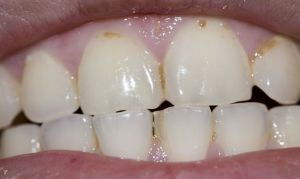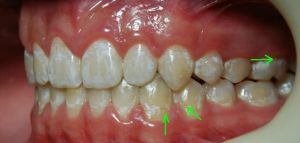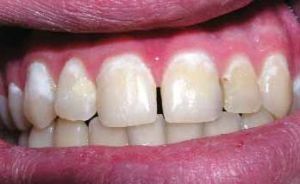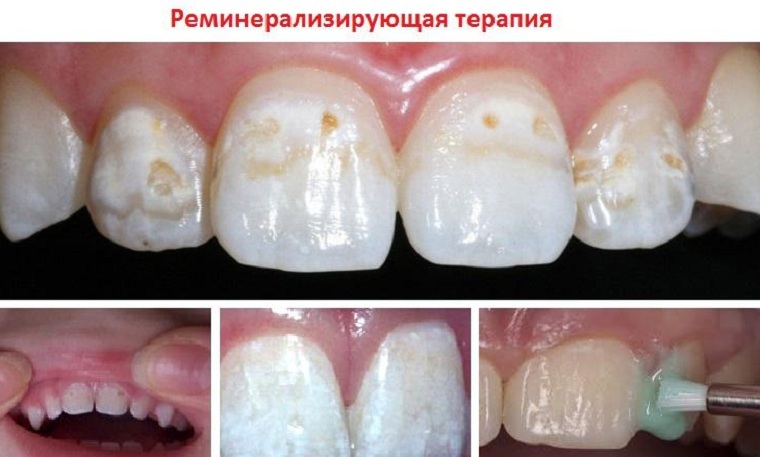 One of the most common dental problems is the demineralization of enamel. A similar state is manifested by significant darkening and deformation of the enamel, lack of shine of teeth and appearance of characteristic white spots on them.
One of the most common dental problems is the demineralization of enamel. A similar state is manifested by significant darkening and deformation of the enamel, lack of shine of teeth and appearance of characteristic white spots on them.
Most often, this process is the first sign of the development of carious disease. However, for an accurate determination of the cause of the loss of minerals by enamel, it is necessary to consult a specialist. In order to identify demineralization, it is important to know what a similar phenomenon is.
This term describes the process of elution from the enamel of mineral substances. The most important of them - calcium, potassium, fluoride, magnesium, chlorine and phosphorus - components that enrich the dental tissue.
In a healthy demineralization organism, remineralization, that is, the regeneration of mineral structures, resists. Normally, these processes are balanced, but in modern people, the process of leaching substances more often than recovery. As a result, the enamel loses its strength and begins to deteriorate.
Contents
- Chemical implications
- Main causes
- Focal lesions
- Symptomatic
- Dental care
- Preventive measures
Chemical implication
One of the main constituents of dentin, enamel and cement of the tooth is hydroxyapatite. Normally, this component is in parity with oral fluid, saturated with calcium and phosphorus.
However, if the acidity of the oral cavity falls below 5.5, hydrogen ions begin to interact with the phosphate group. As a result of the reactions, orthophosphates are formed, which negatively affect the bonds of hydroxyapatite and the process of elution of minerals occurs.
The main causes of
The main reasons for the enamel to begin to lose excessively necessary minerals: 
- carious bacteria;The remains of carbohydrate products.
As a result of staying in the oral cavity of bacteria or carbohydrate food, the acid-base balance decreases. As a consequence, the process of remineralization is broken and enamel destruction occurs. In addition to the main reasons, experts identify a number of factors that contribute to the development of tooth demineralisation:
- absence or improper oral hygiene;
- inflammatory gum disease;
- chronic adrenal and thyroid gland diseases;
- diabetes mellitus;
- disorder or restructuring of the hormonal background;
- use of orthodontic constructions;
- a boring arrangement of teeth;
- increased consumption of fast carbohydrates.
These factors favorably influence the washing process, increase the risk of complete destruction of enamel. That's why they should be avoided and promptly consult a specialist in case of the first suspicions.
Focal defeat
The earliest stage in the development of the demineralization process is focal enamel damage. At this stage, white enchanting spots appear on the enamel, localizing at the joint or in the base, as a rule, 1-2 teeth are affected.
 The size of such a spot can vary from barely noticeable on the surface to occupying most of it. Most often, this disorder occurs in children under 11 years old. In adulthood is much less common.
The size of such a spot can vary from barely noticeable on the surface to occupying most of it. Most often, this disorder occurs in children under 11 years old. In adulthood is much less common.
At this stage tooth decay does not have any additional symptoms, therefore, without careful monitoring of dental health, it is extremely difficult to detect focal demineralization.
Symptomatic symptoms of
To reveal the process of demineralization of teeth is simple enough, for this purpose it is necessary to closely monitor the oral cavity and in case of the appearance of the first symptoms contact the dentist.
In the early stages, leaching of minerals is accompanied by a decrease in the gloss of teeth, the surface becomes dull. After that, there are more obvious symptoms, they include:
- appearance of deformation, the enamel acquires roughness;
- appearance of petty spots, streaks;
- gradually white spots darken and acquire a brown tint;
- tooth surface becomes porous.
To consult a dentist is recommended at the earliest stages of the disease, because in this case it is better treatable.
Dental care
Complex treatment methods depend on the degree of development of demineralization. In the early stages, there are enough procedures for remineralization, at a later stage, a filling with cleaning of the carious focus is shown. At the moment, the most common component of treatment is remineralization therapy. This method involves several mandatory steps:
- Professional oral cleansing.
- Drying of tooth enamel.
- Recovery component - application of medicinal preparations with ions of calcium and potassium.
- Application of protective and strengthening preparations. In this case, most often, special caps are used with a 4% solution of sodium fluoride.

This method of restoring the enamel is painless, and the whole process takes 30-40 minutes. For maximum effect, a minimum of ten sessions is recommended. No less effective way to combat leaching of minerals is fluorination, but at the moment the procedure is not very popular.
Preventive measures
A warning complex to prevent the washing out of minerals from the tooth enamel implies the observance of a number of rules:
- Regular and proper hygiene of the oral cavity. Dentists recommend brushing your teeth after each meal, alternating with
 with calcium and paste with fluoride.
with calcium and paste with fluoride. - Annual visit to the dental office. Many experts advise to increase the conduct of inspections up to two times a year.
- Compliance with the rules of healthy eating. Inclusion in the diet of vitamins and minerals enriched with food, reducing the use of fast carbohydrates.
- Normalization of water-salt balance.
- Use of complex multivitamins.
Compliance with these recommendations for prevention - a guarantee of reducing the risk of dental diseases.
Demineralization is a common pathology affecting the state of tooth enamel. As a rule, it is a symptom of the development of carious disease.
Because caries in the later stages can cause tooth loss, it is necessary to turn to specialists in the first stage of the destructive process, since in this case it is possible not only to avoid removal, but also the procedures for sealing.
